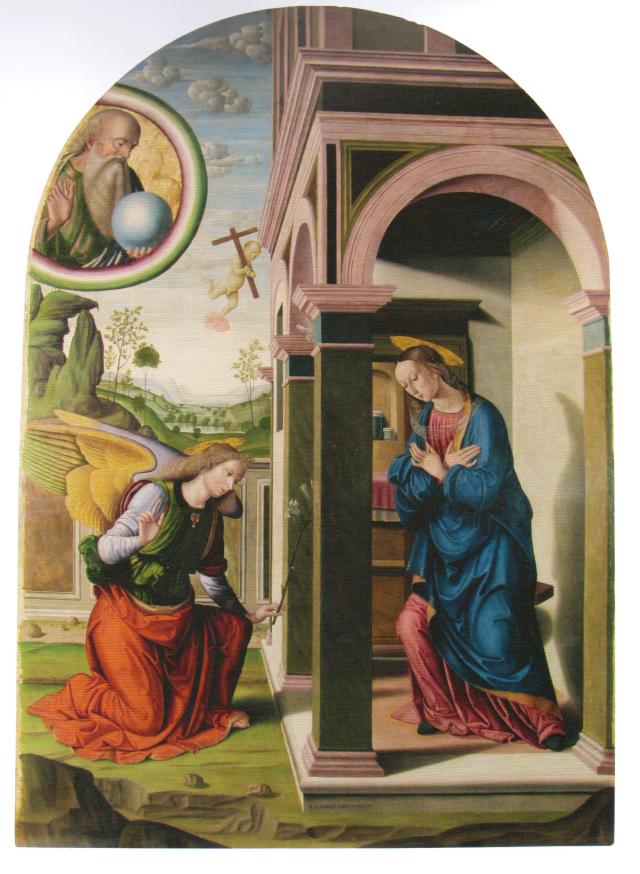I can’t resist sharing this quote from Civilisation, by Kenneth Clark, art historian, (rich, leftish, money from Clark’s cotton reels), father of the [more?] famous Alan Clark, politician and diarist, (rich, right-wing, money from Clark’s cotton reels), about Giovanni Santi, artist, father of the more famous artist, Raphael. “The court painter was a silly old creature named Giovanni Santi, the sort of obliging mediocrity who is always welcome in courts, even in the court of Urbino. No doubt the ladies, when they were in need of a design for embroidery, used to say “Let’s send for dear old Mr Santi” – and when he came he brought with him his beautiful little son, Raffaello. And so Raphael … found his earliest impressions of harmony and proportion and good manners in the court of Urbino. ” (Kenneth Clark: Civilisation ch.4, p.87. London, Penguin, 1987.) Well, dear old Lord Clark probably knew very well that the silly old creature had brought his son up to be a courtier. Of course Clark knew Vasari’s biography of Raphael and his description of dear old Mr Santi which I quoted last time. He probably had seen Raphael’s draft of a poem in his elegant italic hand many a time in the British Museum (Cat 84 in the National Gallery exhibition), and knew that Raphael was a friend of intellectuals at the court of Urbino such as Baldassare Castiglione,

Baldassare Castiglione c 1515
author of the Courtier, whose portrait he painted, and the humanist Pietro Bembo. So he tried to express this in a “popular” way.
The more you write about someone, the more fond you get of them, so I thought I would list some of the places in Le Marche and elsewhere where you can see dear old Mr Santi’s work.
Cagli, San Domenico, Tiranni Chapel.
Fano, Sta Maria Nuova
Visitation

Giovanni Santi. Visitation c1488-1490, Sta Maria Nuova, Fano. Thanks to the Ministero per i Beni e le Attivita Culturali.
Note the similarity between the figure second from the spectator’s left and the Muse Clio in the Royal Collection below.
Florence, Galleria Corsini
The Muse Clio
London, National Gallery (not on show)
Note the tilted oval of the Virgin’s head.
Santi often portrayed her in this way, for instance in his Annunciation, on display in Raphael’s birthplace in Urbino.
Montefiorentino; Convent
Madonna enthroned with Saints.
Urbino, Galleria Nazionale delle Marche
The Dead Christ supported by Two Angels ( and many other paintings).

Giovanni Santi: Dead Christ Supported by Two Angels. Thanks to http://www.pubhist.com
This particular painting is supposed to have been placed on the edge of the pulpit in San Bernadino degli Zoccolanti, the Montefeltro mausoleum. (Raphael from Urbino to Rome: London; National Gallery, 2004, cat 5, p76.)





I wonder how many other maestri have sprung somewhat mediocre fathers? From my instant memory neither Leonardo nor Michelangelo had any artists in the family – and neither did Titian, I suspect.
Obviously the most important factor was for the family to have enough connections/knowledge to get the budding genius into the workshop of a master.
Do we know of any Marche artists who emerged without the benefit of a proper workshop training? Who were, in other words, self-taught.
Anyway, at least Santi was good enough to be bought by the Queen.
LikeLiked by 1 person
Pingback: Giovanni Santi, the artist Raphael’s father | Le Marche another Italy | Scoop.it
Pingback: Giovanni Santi, the artist Raphael’s father | Good Things From Italy - Le Cose Buone d'Italia | Scoop.it
Pingback: Giovanni Santi, the artist Raphael’s father « goodthingsfromitaly
Pingback: Giovanni Santi, the artist Raphael’s father | BEAUTY ART | Scoop.it
Pingback: Giovanni Santi, the artist Raphael’s father | Adventure World | Scoop.it
Pingback: Suasa update | Hill towns of the Marche, Italy
Pingback: The “Annunciation” painted by Giovanni Santi, Raphael’s father | Hill towns of Le Marche, Italy
Pingback: Culturespaces | Le Pérugin, Maître de Raphaël, Musée Jacquemart-André, Paris | Hill towns of Le Marche, Italy